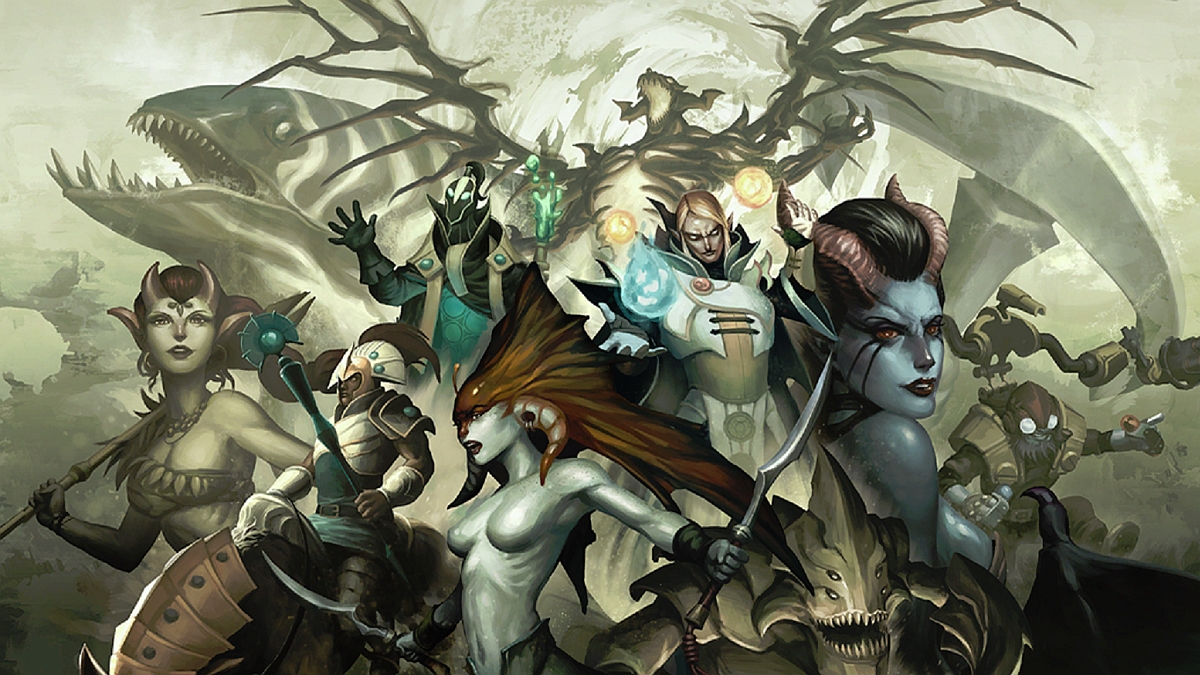In praise of the secret language of Dota 2's drafting phase

Every week, Chris documents his complex ongoing relationship with Dota 2, Smite, and wizards in general.
The art above is a detail from 'Caucus of Heroes', part of the Kunkka Loading Screen Bundle.
I first watched competitive Dota during the second International. I'd been playing for a few months, and didn't understand enough to follow the tournament properly. My abiding memory of those first experiences was watching the draft: particularly the moment when a team would select a hero, the portrait would flash up on the screen, and a crowd of people on the other side of the planet would go wild. It was baffling, almost off-puttingly so, but I wanted to understand it.
Competitive games always develop their own secret languages—it's not something unique to Dota 2 or even this genre. But drafting sits aside from even these. Learning to parse the drama of a character selection phase is something that comes after picking up basic understanding of the game itself. It requires a knowledge of every character, their strengths, the strategies they fit into and the players they're associated with. It requires knowledge of past results, the current metagame, the history of the competitive scene, and so on. Not all of that knowledge needs to be perfect, but as with any language the more fluent you are the more you understand.
A little over three years later, the pick-ban process has become one of my favourite things about Dota. I'm not sure how unusual that is: it's the precursor to a much more involved and complex game, a phase that you're likely to fast-forward through if you're catching up on a replay. Only a small portion of the playerbase opt to play Captain's Mode regularly. For me it's become its own game, antecedent to Dota proper but interesting, and strangely playable, in its own right.
Drafting feels a bit like a competitive card game from the future. It's the part of Dota that hews closest to Calvinball—and this is game that has an awful lot of Calvinball in its DNA.
For example. EG remove Bounty Hunter and Tusk; CDEC remove Leshrac and Techies. EG first pick Gyrocopter and CDEC take Clockwerk and Lina. EG get Naga Siren, then remove Ember Spirit. CDEC get rid of Dark Seer. EG get rid of Visage. CDEC ban Shadow Fiend then take Winter Wyvern. Storm Spirit to EG, then Phantom Lancer to CDEC, then Earthshaker to EG. CDEC remove Crystal Maiden; EG remove Dazzle. Down to the final two: Dragon Knight for CDEC, Ancient Apparition to EG.
This is either complete nonsense or the dramatic opening moments of the final game of the International 2015. It's probably a little bit of both. Over time however, and exposure, you see the stories contained in every choice. The way EG's Bounty Hunter ban reflects their growing respect for the hero, the way it upset them in the upper bracket final, its gradual ascendance over the course of the event. CDEC's Techies ban, which echoes with the sound of Aui_2000's explosive performance in the group stages (and KuroKy's back at ESL One, arguably.)
The respect shown to Universe with the Dark Seer ban and, likely, the Clockwerk first-pick; similarly, EG's respect for Q's Visage. The confidence in SumaiL expressed by that third-pick Storm Spirit, the shore-up-the-defenses mindset expressed by Phantom Lancer and Dragon Knight. The reason people cheer at hero selections is because they express personality, emotion, and strategy: the thing you see, when you learn to read between the lines, is people, which is a good way to explain the popularity of esports as a whole.
The biggest gaming news, reviews and hardware deals
Keep up to date with the most important stories and the best deals, as picked by the PC Gamer team.
What strikes me is that even spectating a draft phase is, to some degree, participatory. It's fun to apply your own understanding to the draft happening on the screen, to anticipate decisions, share that anticipation, and so on. This is a part of the game that is fundamentally about pattern recognition, but rare in that the patterns you trace go beyond game mechanics and strategy. You consider social, personal, historical patterns too: you are using the part of your brain that might in a different life be forecasting financial trends, or branding, or fashion. Whatever life decisions led you apply these faculties to internet wizards don't matter: you are, at least, using them.
It's the satisfaction of applying years of knowledge knowledge and intuition in combination, simply and keenly expressed—something few games outside of the competitive world manage. For all that gets said about esports being inaccessible, I suspect that the complexity of a hero draft is emblematic of why they're becoming so popular. It's common to assume that a viewer will encounter something they don't understand and turn away: those cheers during the draft are evidence that the opposite is often true. Secret languages are attractive—they draw people in, make them want to learn, and reward them for learning. I can't think of a better demonstration of that than thousands of people screaming at a character select screen.
To read more Three Lane Highway, click here.
Joining in 2011, Chris made his start with PC Gamer turning beautiful trees into magazines, first as a writer and later as deputy editor. Once PCG's reluctant MMO champion , his discovery of Dota 2 in 2012 led him to much darker, stranger places. In 2015, Chris became the editor of PC Gamer Pro, overseeing our online coverage of competitive gaming and esports. He left in 2017, and can be now found making games and recording the Crate & Crowbar podcast.


